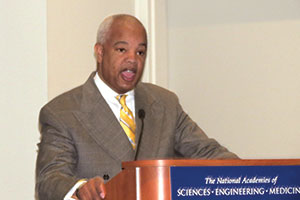FMCSA to Take Comments on Safety Fitness Proposal This Month

WASHINGTON — Federal Motor Carrier Safety Administration acting Administrator Scott Darling said the agency will soon publish its proposal for safety fitness determination.
He made the announcement while addressing the Transportation Research Board’s annual meeting here Jan. 11.
“Before the end of this month we will publish the safety fitness determination proposal,” Darling said. “It will change the agency’s safety rating process by incorporating current on-road safety performance data.”
Fitness is based on the carrier’s performance in relation to the agency’s Behavioral Analysis and Safety Improvement Categories, or BASIC, an investigation or a combination of on-road safety data and investigation information. The intended effect of this action is to reduce crashes caused by commercial motor carriers, resulting in death, injuries and property damage on U.S. highways, FMCSA said.
Separately, a Senate hearing on Darling’s nomination to be the permanent FMCSA chief has been set for Jan. 20, Transport Topics learned from a Commerce Committee source. Darling has been serving in the acting role since Aug. 5.
Asked by TT earlier in the week about his long wait without a hearing, Darling said, “I’m going to do my job. The work that we do is important because safe trucking moves the economy. When Congress wants to see me, I will be there.”
Meanwhile at TRB, Darling also said the agency will complete the initial implementation of a new online unified registration system. The system, which went active Dec. 12, combines multiple reporting forms into a single “smart form” that streamlines the registration and renewal process, improves efficiency, reduces errors and strengthens safety for the motoring public.
“URS combines various forms that carriers, freight forwarders and brokers currently use to register and update their information with the agency into a single, online registration application,” FMCSA announced last month.
FMCSA will also implement the next phase of the Compliance, Safety, Accountability program to better identify at-risk carriers.
“This year, we are setting a high bar for ourselves as we advance our safety mission,” Darling said.
He described the new year as one of “exciting” possibilities. “We’re going to be working a lot with all our stakeholders to make sure we get the FAST Act provisions implemented as quickly as possible. We had a big year in 2015, and we have a big year ahead of us in 2016. We are ramping up our efforts to broaden and deepen our partnerships with state and local governments, law enforcement, safety advocates, labor [and] the trucking industry. Our partners are our force multipliers. We perform at our highest level when we work closely with them.”
Among those partners are the National Academies of Science, which Darling said is teaming with FMCSA to study CSA. The agency also is studying the effects of round-trip commutes on drivers who work more than 150 miles from their homes, and is considering giving credits to carriers for using advanced safety equipment, enhanced driver fitness measures and fleet safety management tools.
The agency’s William Quade said FMCSA will propose standards shortly for entry-level drivers and is planning to launch a pilot program for drivers younger than 21 who have military experience from actual service as well as in the Reserve and the National Guard.
Quade also said FMCSA soon will issue a final rule on the national drug-and-alcohol database of truck drivers who fail their drug-and-alcohol tests, but is waiting on the Department of Health and Human Services before it can move ahead on hair testing.
“Contrary to popular belief, we don’t sit in our building in Washington and look for ways to mess with the trucking industry,” Quade said. “The goal is to put in place systems that improve safety. We believe that the safety fitness determination proposal will do that.”

